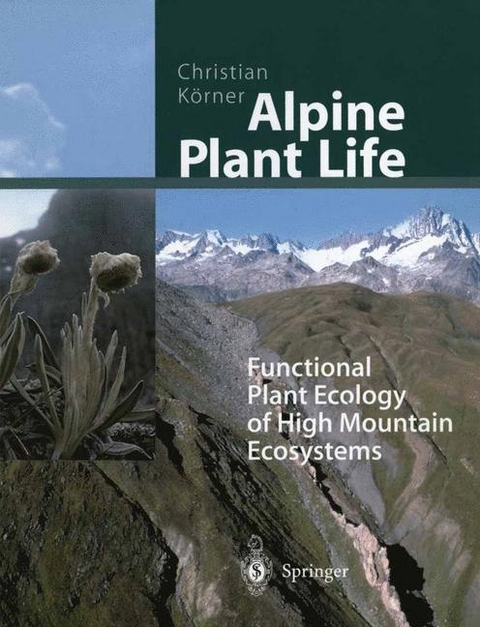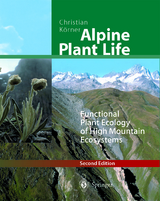
Alpine Plant Life
Springer Berlin (Verlag)
978-3-540-65438-4 (ISBN)
- Titel erscheint in neuer Auflage
- Artikel merken
Christian Körner was born in 1949 in Salzburg, Austria, got his academic degrees from the University of Innsbruck, and became professor of botany at the University of Basel, Switzerland in 1989. He published over 300 scientific articles on plant-environment interactions and authored and coauthored numerous scientific books, including the leading plant science textbook Strasburger.
1 Plant ecology at high elevations.- The concept of limitation.- A regional and historical account.- The challenge of alpine plant research.- 2 The alpine life zone.- Altitudinal boundaries.- Global alpine land area.- Alpine plant diversity.- Origin of alpine floras.- Alpine growth forms.- 3 Alpine climate.- Which alpine climate?.- Common features of alpine climates.- Regional features of alpine climates.- 4 The climate plants experience.- Interactions of relief, wind and sun.- How alpine plants influence their climate.- 5 Life under snow: protection and limitation.- Temperatures under snow.- Solar radiation under snow.- Gas concentrations under snow.- Plant responses to snowpack.- 6 Alpine soils.- Physics of alpine soil formation.- The organic compound.- The interaction of organic and inorganic compounds.- 7 Alpine treelines.- About trees and lines.- Current altitudinal positions of climatic treelines.- Treeline-climate relationships.- Intrazonal variations and pantropical plateauing of alpine treelines.- Treelines in the past.- Attempts at a functional explanation of treelines.- A hypothesis for treeline formation.- Growth trends near treelines.- 8 Climatic stress.- Survival of low temperature extremes.- Avoidance and tolerance of low temperature extremes.- Heat stress in alpine plants.- Ultraviolet radiation — a stress factor?.- 9 Water relations.- Ecosystem water balance.- Soil moisture at high altitudes.- Plant water relations: a brief review of principles.- Water relations of alpine plants.- Desiccation stress.- Water relations of special plant types.- 10 Mineral nutrition.- Soil nutrients.- The nutrient status of alpine plants.- Nutrient cycling and nutrient budgets.- Nitrogen fixation.- Mycorrhiza.- Responses of vegetation to variable nutrient supply.- 11 Uptake and loss of carbon.- Photosynthetic capacity of alpine plants.- Photosynthetic responses to the environment.- Daily carbon gain of leaves.- The seasonal carbon gain of leaves.- C4 and CAM photosynthesis at high altitudes.- Tissue respiration of alpine plants.- Ecosystem carbon balance.- 12 Carbon investments.- Non-structural carbohydrates.- Lipids and energy content.- Carbon costs of leaves and roots.- Whole plant carbon allocation.- 13 Growth dynamics.- Seasonal growth.- Diurnal leaf extension.- Rates of plant dry matter accumulation.- Functional duration of leaves and roots.- 14 Cell division and tissue formation.- Cell size and plant size.- Mitosis and the cell cycle.- From meristem activity to growth control.- 15 Plant biomass production.- The structure of alpine plant canopies.- Primary productivity of alpine vegetation.- Plant dry matter pools.- Biomass losses through herbivores.- 16 Plant reproduction.- Flowering and pollination.- Seed development and seed size.- Germination.- Alpine seed banks and natural recruitment.- Clonal propagation.- Alpine plant age.- 17 Global change at high elevation.- Alpine land use.- The impact of altered atmospheric chemistry.- Climatic change and alpine ecosystems.- References (with chapter annotation).- Taxonomic index (genera).- Color Plates.- Plant life forms.- The alpine life zone.- Environmental stress.- The human dimension.
| Erscheint lt. Verlag | 26.5.1999 |
|---|---|
| Zusatzinfo | IX, 343 p. |
| Verlagsort | Berlin |
| Sprache | englisch |
| Maße | 193 x 270 mm |
| Gewicht | 794 g |
| Themenwelt | Naturwissenschaften ► Biologie ► Botanik |
| Naturwissenschaften ► Biologie ► Ökologie / Naturschutz | |
| Schlagworte | Alpen • Alpen /Biologie • Alpenpflanzen • alpine ecology • cell division • Climate • Cyclin • Ecology • ecosystem • Environment • Flora • HC/Biologie/Botanik • high mountains • Hochgebirge • Klima • Mineral Nutrition • nitrogen • nutrient cycling • Ökologie • Ökosystem • Pflanzenökologie • plant development • plant ecology • Planzenökologie • Relief • Roots • Temperature • Vegetation • Wind |
| ISBN-10 | 3-540-65438-0 / 3540654380 |
| ISBN-13 | 978-3-540-65438-4 / 9783540654384 |
| Zustand | Neuware |
| Informationen gemäß Produktsicherheitsverordnung (GPSR) | |
| Haben Sie eine Frage zum Produkt? |
aus dem Bereich



